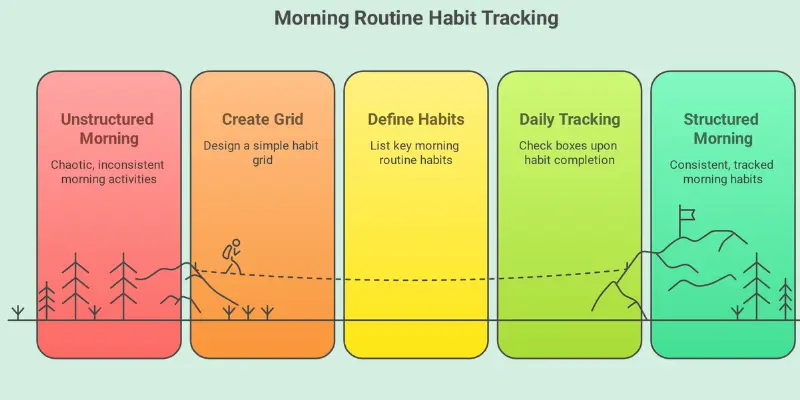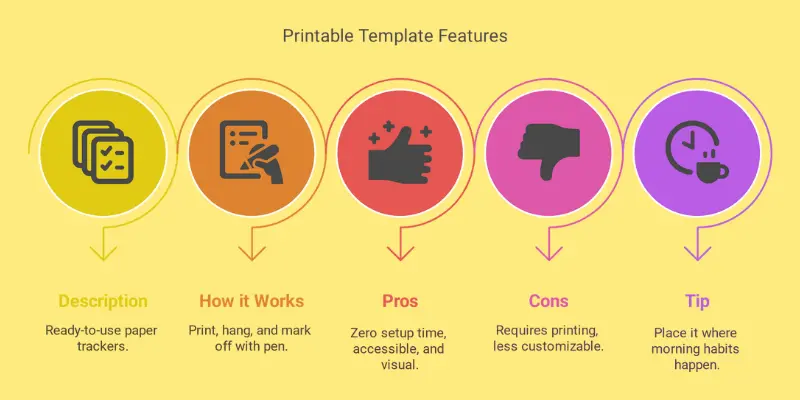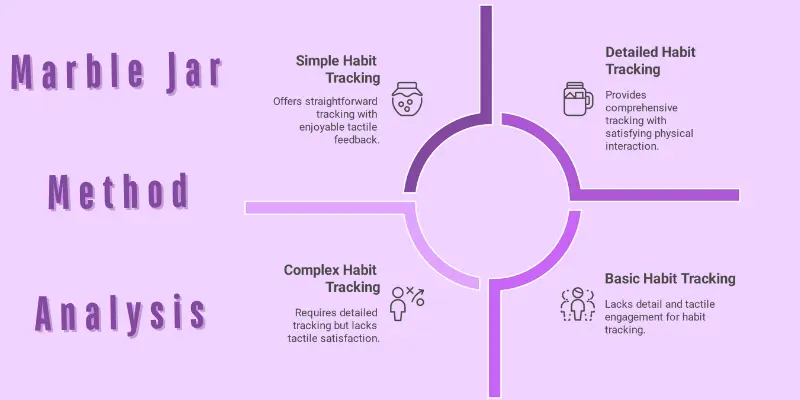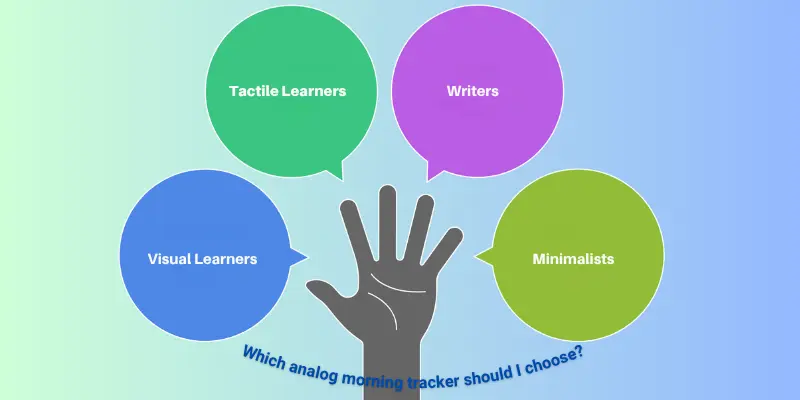7 Simple Analog Habit Trackers for a Calmer, Screen-Free Morning Routine
Published: 30/06/2025
In today’s world, the constant pull of digital devices is a never-ending battle. As soon as we open our eyes, we’re bombarded by notifications, emails, and endless social media updates. It’s no wonder that many of us feel overwhelmed and distracted right from the start of the day. The moment we reach for our phones, our mornings are hijacked, leaving little room for focus, clarity, or intentionality.
You’re not alone if you’ve ever found yourself scrolling mindlessly through your phone, only to realize an hour has passed, and your morning routine is already off track. The struggle to break free from this digital chaos can feel impossible, but it doesn’t have to be.
What if there was a way to reclaim your mornings and start your day with peace, consistency, and focus—without ever looking at a screen? That’s where simple analog habit trackers come in. By using tangible methods to track your morning habits, you can create a calm, intentional routine that sets the tone for the rest of the day.
In this post, we’ll walk through 7 simple analog habit trackers that will help you break free from digital distractions and build a morning routine that’s all your own. From a classic bullet journal to more tactile options like marble jars, these methods will help you stay on track and feel empowered as you begin each new day.
Why Go Screen-Free? The Power of an Analog Morning
Starting your day without the distraction of a screen can set the tone for a more focused, intentional morning—and it can offer a range of physical and mental benefits. Here’s why embracing a screen-free morning can be a game-changer:

Benefits of a Screen-Free Morning
- Reduced Stress and Anxiety: The moment you pick up your phone, you’re often met with a flood of notifications, emails, and news updates. These can trigger stress and overwhelm, leading to a chaotic start. A screen-free morning helps you avoid this, giving you a calmer, more peaceful beginning to your day.
- Improved Focus and Clarity for the Day Ahead: Without the distractions of digital devices, your mind can focus on what really matters. Whether it’s taking time for mindfulness, completing your morning habits, or planning your day, you’ll find it easier to center your attention and feel more clear-headed.
- A More Mindful and Intentional Start: Instead of jumping straight into your digital world, a screen-free morning allows you to be more mindful. You’re not reacting to external distractions; you’re focusing on the activities that matter to you—whether it’s journaling, stretching, or simply enjoying a cup of coffee. This sets a tone of intentionality that can carry through the rest of the day.
- Better Sleep Quality: Early morning exposure to blue light—whether from your phone or other devices—can disrupt your body’s natural circadian rhythm, making it harder to get a restful night’s sleep. By avoiding screens first thing, you’re helping to regulate your body’s internal clock, leading to improved sleep quality and more energy throughout the day.
- A Deeper Connection with Your Routine, Not Your Device: Analog habits give you a tangible connection to your morning routine. There’s something grounding about physically checking off habits, writing in a journal, or moving a marble in a jar. This brings a sense of accomplishment and focus that digital devices often cannot provide.
To be a digital minimalist means to be at peace with your internal world and to not feel the constant pull to check your devices.Cal Newport, author of Digital Minimalism
The Science Behind Analog Tracking
The act of tracking habits analog-style—whether through writing, ticking boxes, or physically interacting with objects—has a number of psychological benefits that digital methods can’t match. Here’s why analog tracking works:
- Visual Progress: When you see your progress laid out in front of you, like a series of checkmarks or a growing streak on a wall calendar, your brain receives immediate positive feedback. This visual progress boosts motivation and reinforces your commitment to the habit.
- Tangible Satisfaction: There’s something uniquely satisfying about physically marking off a task. This tangible act of writing or moving a token (like a marble or coin) triggers your brain’s reward system, giving you that “feel-good” sensation that keeps you coming back.
- Reduced Decision Fatigue: One of the biggest advantages of analog tracking is that it eliminates the need to constantly decide what to do next. Instead of scrolling through an app or list of tasks on your phone, a simple habit tracker guides you, allowing you to focus your energy on the task at hand rather than on deciding what to do next.
The power of habit reinforcement also comes into play. The physical act of marking your progress is a key component of reinforcing a habit. It makes the action more concrete in your mind, linking your behavior to the reward, and strengthening the neural pathways involved in forming habits. The sense of accomplishment you feel when you check off a task isn’t just satisfying; it’s helping you to solidify that habit into your daily routine.
7 Simple Analog Habit Trackers for Your Morning Routine
In this section, we’ll dive into seven simple analog habit trackers that can help you build a calm, screen-free morning routine. Each method is easy to implement and will provide the structure and accountability you need without relying on digital devices.
The Classic: Bullet Journal / Habit Grid
A bullet journal is a simple yet highly customizable tool that allows you to design your own habit-tracking system. Using a basic grid layout, you can track your daily habits in a way that works best for you.
How it Works for Mornings: In the morning, you create a grid with checkboxes for various habits like “Hydrate,” “Meditate,” “Journal,” or “Exercise.” As you complete each habit, you simply mark the box with a check or an “X.” The visual representation of your progress helps build consistency and accountability.
Pros:
- Highly Customizable: You can design your bullet journal exactly the way you want it, adding creative touches and personal flair.
- Creative Outlet: Bullet journaling is a great way to express your personality through design while also staying organized.
- No Tech Needed: Since everything is done by hand, you won’t need to rely on any digital devices or apps, making it perfect for a screen-free morning.
- Personal: It’s a deeply personal way to track your habits, and you can tailor it to your own preferences and needs.

Cons:
- Can Feel Overwhelming for Beginners: If you’re new to bullet journaling, it can be easy to over-complicate your design, which might lead to frustration or loss of interest.
- Time-Consuming to Set Up: Creating a bullet journal habit grid from scratch takes some initial effort, especially if you want to make it visually appealing.
Tip: Keep it simple! Start with a basic grid layout and a few essential habits to track. You don’t need to over-complicate things—just a few checkboxes for the most important habits will keep you focused without feeling overwhelmed.
Instant Gratification: The Printable Template
A printable habit tracker is a ready-to-use, no-fuss tool that requires little effort to implement. This method involves printing a pre-designed habit tracker template and using it to check off your morning habits each day.
How it Works for Mornings: Simply download and print a habit tracker template that fits your morning routine. Place it somewhere highly visible, such as on your fridge or mirror. As you complete your morning habits—like drinking water, stretching, or journaling—mark them off with a pen. The visibility and ease of use make this an effective way to stay on track.
Pros:
- Zero Setup Time: Once you download the template and print it, you’re ready to go. No design or customization is necessary, making it ideal for busy mornings.
- Highly Accessible: You don’t need to be tech-savvy to use this method—just print and mark off your habits each day.
- Very Visual: The tracker is right in front of you, making it easy to see your progress at a glance, which helps keep you motivated.
- Perfect for Beginners: For those new to habit tracking, this method is simple and straightforward, with no complicated setup required.

Cons:
- Requires Printing: If you don’t have access to a printer, this method might not be ideal. Additionally, some may find it wasteful to print a new tracker each time.
- Less Customizable: Unlike a bullet journal, this tracker is less flexible when it comes to creative design or adapting it to unique needs.
Tip: Place your printable tracker in a spot where you’ll naturally see it as part of your morning routine. The fridge or bathroom mirror are great places, as they’re highly visible and help reinforce the habit right after you wake up.
Expert Addition: To help you get started, I’ve created a FREE downloadable template for you! This will make tracking your morning habits even easier. Grab your template and start building your screen-free morning routine today!
Big Picture View: The Wall Calendar System
The wall calendar system is a simple and visual way to track your morning habits. Using a large wall calendar or whiteboard, you mark each day you complete your habit, making it easy to see your progress over time. This method is perfect for those who enjoy a big-picture view of their habits and like seeing the chain grow.
How it Works for Mornings: Every morning, once you complete your morning habit (e.g., drinking water, exercising, meditating), mark a big ‘X’ on that day’s date on the calendar. The more ‘X’s you see, the more motivated you’ll be to keep the chain going. This method is especially satisfying because you can physically see your progress grow each day.
Pros:
- Extremely Visual: The wall calendar system offers an instant, visual representation of your progress. It’s rewarding to see the chain of ‘X’s grow as you consistently complete your habits.
- Group Habits Easily: It’s great for tracking multiple habits at once, allowing you to visualize and keep track of various morning routines.
- Great for Accountability: If you place the calendar in a visible spot, like in a common area or near the entrance, it can serve as a great tool for accountability. Others will notice the chain, and that added visibility might encourage consistency.
Cons:
- Limited Space for Notes: A wall calendar doesn’t allow much room for detailed notes or additional habit tracking. If you like to track a variety of aspects, this might feel too limiting.
- Less Private: Since a wall calendar is often placed in a visible area, it might not be the best option if you want to keep your habits private or only track personal goals.
Tip: To keep things engaging, use different colored markers for different habits. This way, you can easily track multiple habits on the same calendar and enjoy the visual variety as the days pass.
The Tactile Tracker: Marble Jars / Jar Counting
The marble jar method is a tactile and satisfying way to track your morning habits. This simple tracker involves moving a physical object—such as a marble, button, or coin—from one jar to another each time you complete a habit.
How it Works for Mornings: For every completed habit, like drinking a glass of water or meditating, you move a marble (or any small object) from one jar to another. The immediate physical action is rewarding, and watching the marbles accumulate is a fun and motivating visual reminder of your consistency.

Pros:
- Highly Tactile and Satisfying: The physical act of moving a marble provides instant gratification, making the process engaging and enjoyable. This is especially motivating for people who love physical interaction rather than just writing.
- Great for Kids (or Kid-like Adults!): This method is fun and can be a great way to get children involved in habit tracking, but it’s also great for adults who like a more playful approach to routine-building.
- No Writing Required: If you don’t want to spend time writing or drawing, this method is a great option. Simply move an object, and you’re done!
Cons:
- Less Detail: The marble jar method doesn’t provide much room for tracking complex habits or making detailed notes. It’s a simple method that works best for clear, binary habits (i.e., did you do it or not?).
- Can Only Track Binary Habits: This method is most effective for habits that have a clear “yes/no” outcome. It’s less suited for habits that require a more nuanced approach (e.g., meditation for 10 minutes vs. 30 minutes).
Tip: Use clear jars to make it easy to see your progress. Watching the marbles accumulate will give you a visual reminder of how far you’ve come and keep you motivated to continue.
Simple & Direct: The Tally Mark Method
The tally mark method is one of the simplest ways to track your morning habits. All you need is a small piece of paper or a sticky note, where you mark a tally for every completed habit. This ultra-minimalist approach works perfectly for those who want a quick, straightforward way to keep track without any distractions.
How it Works for Mornings: Each morning, write a simple tally mark for each completed habit. Whether it’s drinking water, doing a few stretches, or making your bed, each habit gets a quick tick. It’s the fastest way to mark your progress without needing extra tools or setup.
Pros:
- Zero Friction: There’s nothing complicated about this method. It’s quick, easy, and doesn’t require any setup—just grab a pen and start tallying.
- Extremely Portable: You can use this method anywhere—whether at home, at work, or while traveling. No bulky journals or trackers required, just a simple piece of paper or sticky note.
- Private: Since it’s on a small piece of paper, it’s a completely private way to track your habits. You don’t need to worry about others seeing your progress if you prefer to keep it personal.
Cons:
- No Long-Term Data: The tally mark method doesn’t offer much room for tracking long-term trends or insights about your habits. It’s great for short-term tracking but lacks the ability to provide detailed information over time.
- Easy to Lose: A simple piece of paper or sticky note can easily get lost or damaged, especially if you’re not careful about where you place it.
Tip: Keep a small pad and pencil by your bed or wherever you start your morning routine. That way, you can easily mark off your habits right when you complete them, without having to search for your tracker.
The Index Card Flip: Visual Cue & Tracker
The index card flip method is a simple yet effective way to track your morning habits. By writing each habit on a separate index card, you create a visual and physical way to check off each task. Once you complete a habit, you flip or move the card to a “done” pile, offering immediate satisfaction and clear progress.
How it Works for Mornings: Write each of your morning habits—like “Drink Water,” “Meditate,” or “Stretch”—on separate index cards. After completing a habit, simply flip or move the card to a “done” pile. Seeing the pile grow as you complete tasks throughout the morning provides a rewarding, tangible sense of accomplishment.
Pros:
- Simple: The method is easy to implement with minimal setup. All you need are a few index cards and a pen.
- Physical Satisfaction: There’s something satisfying about flipping or moving a card after completing a habit. This tangible action reinforces your progress and gives you instant feedback.
- Good for Short Lists of Habits: This method is great for keeping track of a few key habits. It’s straightforward and highly motivating when used for a small number of tasks.
Cons:
- Can Get Messy if Not Organized: If you have a lot of index cards, they can quickly get scattered or disorganized, which may make the process feel chaotic.
- Only Good for a Few Habits: This method works best when you’re tracking just a handful of habits. It might not be as effective for a long list of tasks or more detailed tracking.
Tip: Keep your index cards organized in a small container or box so they don’t get lost. If you’re tracking a handful of habits, this method is both fun and efficient, but you’ll need to stay organized to avoid a cluttered space.
Habit Stacking with Physical Cues
Habit stacking isn’t a tracker in the traditional sense, but it’s a powerful analog strategy that helps form new habits by linking them to existing ones. This method follows the principle of “After X, I will Y,” a concept popularized by habit expert James Clear. Essentially, you use an already-established habit as a cue to trigger a new one, creating a seamless flow in your morning routine.
How it Works for Mornings: To use habit stacking, you link a new habit to something you already do regularly. For example, after you brush your teeth (the established habit), you could immediately drink a glass of water and mark it on your calendar (the new habit). The key is to anchor your new habit to something that already happens without fail in your routine.
Pros:
- Reduces Friction: Habit stacking makes it easier to start a new habit because it’s tied to something you already do. You don’t have to think about it or carve out new time for it; it simply happens naturally.
- Leverages Existing Routines: This strategy builds on your current habits, making it less overwhelming to introduce something new.
- Builds Strong Neural Pathways: Linking habits helps create new neural pathways, strengthening the behavior over time. By pairing a new habit with an already-established one, you’re more likely to stick with it in the long run.
Cons:
- Requires Conscious Effort to Link: While the process is simple, it does require some initial thought and effort to identify which habits to stack and how to integrate them into your routine. Without this conscious effort, habit stacking may not be effective.
Tip: Use a physical object as a cue to trigger your new habit. For example, place your journal on top of your coffee mug, so when you grab your mug in the morning, you’re reminded to write in your journal right after you drink your coffee.
Choosing Your Perfect Analog Morning Tracker
With so many analog tracking methods available, choosing the one that fits your personality and lifestyle can be a game-changer. It’s all about finding a tracker that feels natural and easy to maintain, so you can stay consistent and build lasting habits. Let’s break down how to pick the perfect method for your morning routine.

Consider Your Personality
The first step in choosing a tracker is understanding your personality. Are you someone who thrives on visuals, or do you prefer a more tactile experience? Maybe you love to write, or you prefer minimalism. Your personality will play a significant role in determining the best fit for you.
- Visual Learners: If you’re motivated by seeing things laid out in front of you, methods like the wall calendar or the printable tracker might be best. These trackers provide instant visual feedback and are perfect for those who like to see progress at a glance.
- Tactile Learners: If you enjoy a hands-on approach, methods like marble jars or the index card flip might be more up your alley. The physical act of moving objects or flipping cards can make the process feel more rewarding.
- Writers: If journaling is part of your morning routine, a bullet journal or habit grid might be your ideal choice. This method allows you to write and track your habits creatively.
- Minimalists: If you prefer simplicity, methods like tally marks or a basic printable template could be perfect. These trackers are straightforward and don’t require much time or energy.
Evaluate Your Morning Style
Next, think about your morning routine and lifestyle. How much time do you have in the mornings? Do you prefer a method that’s visible and helps you stay accountable, or do you want something more private?
- Time Considerations: If your mornings are rushed, a simple tracker like the tally mark method or a printable template might be ideal. These require little setup and can be done quickly. If you have more time to devote to your morning habits, a bullet journal or wall calendar system might be a better fit.
- Visibility vs. Privacy: If accountability is important to you, you might prefer a wall calendar or a large printable tracker in a visible location. On the other hand, if you value privacy, methods like the index card flip or tally marks allow you to keep your progress personal.
- Number of Habits: Think about how many habits you want to track. If you’re focusing on a few habits, a simple tracker like the tally mark method might be enough. For a more comprehensive routine, a bullet journal or wall calendar could accommodate multiple habits.
Start Simple, Then Scale
It’s easy to get excited and want to track everything at once, but starting simple is key. Begin with the easiest method first, and focus on just one or two habits. This will make it easier to stick with the tracker and build momentum. Once you’ve gotten comfortable with your routine, you can scale up by adding more habits or switching to a more complex system.
Remember, the goal is consistency, not perfection. The more you practice, the easier it will be to incorporate new habits into your morning routine.
Expert Tips for Sustainable Morning Habit Tracking
Building a consistent, screen-free morning routine isn’t just about having the right tracker—it’s also about setting yourself up for long-term success. These expert tips will help you maintain momentum, stay on track, and make your habit tracking truly sustainable.
Start Small & Build Momentum
One of the most common mistakes people make when starting a new habit is aiming too high too soon. For example, if your goal is meditation, starting with 30 minutes might feel overwhelming. Instead, start with 5 minutes. This smaller commitment is easier to stick to and will help you build momentum. Once you’ve consistently hit your goal for a few days, you can gradually increase the duration or complexity. Small wins add up quickly, and you’ll feel more motivated to continue.
The Power of the Streak
Have you ever heard of “not breaking the chain”? It’s a simple yet powerful concept: the idea that the longer you keep a streak going, the more motivated you’ll be to continue. Whether you’re tracking your habits on a wall calendar or in a bullet journal, seeing a chain of “X’s” or checkmarks grow day by day is incredibly motivating. It turns the process into a game—one where you don’t want to break your streak, no matter how small the task might be.
Forgive Yourself, Don’t Break Forever
Life happens. There will be days when you miss your habit or fall off track. The key is not to let it derail you. Instead of feeling discouraged, forgive yourself and get back on track the next day. One missed day doesn’t undo all the progress you’ve made. The important part is getting back on the horse immediately. Remember, habits take time to form, and consistency over weeks and months is what truly matters.
Place Your Tracker Strategically
Where you place your habit tracker is just as important as which tracker you choose. Visibility is key. If your tracker is hidden away, it’s easy to forget about it. Place it somewhere you’ll see it immediately after completing your habit, such as by your coffee machine, on your bathroom mirror, or next to your bed. When you’re reminded of your tracker in those critical moments, it becomes easier to stick with your routine.
Review and Adjust
Don’t be afraid to review your progress regularly. Every few weeks, take a moment to reflect on how you’re doing. Are your habits sticking? Are you feeling motivated, or do you need to adjust your approach? It’s normal for habits to evolve over time. If you find a tracker isn’t working for you, try switching it up. Flexibility is key to long-term success.
Connect to Your “Why”
Finally, always keep in mind why you’re tracking your habits in the first place. Whether it’s to feel calmer, be more productive, or improve your well-being, remind yourself of the bigger picture. Connecting to your “why” strengthens your commitment and keeps you focused on the benefits of your new routine. When you feel yourself slipping, remembering your purpose can reignite your motivation.
Making Your Screen-Free Mornings Stick: The Final Word
In a world where digital distractions often take center stage, simple analog habit trackers provide a refreshing way to reclaim your mornings. By embracing these tangible, screen-free tools, you can start your day with intention, focus, and peace—free from the overwhelming pull of your phone. Whether you’re tracking habits with a bullet journal, a wall calendar, or a jar of marbles, these methods help establish routines that stick, while fostering a deeper connection to your mornings.
The benefits are clear: reclaiming your mornings means more calm, more consistency, and more control over the day ahead. With just a few minutes of analog tracking, you can set the tone for a more mindful and productive routine.
So, why wait? Pick one of the methods outlined in this post and start today. It’s time to take back your mornings and create a routine that works for you.
- “Which analog method are you excited to try first? Share your thoughts in the comments below!”
- “Looking for a great way to start your day? Choose your favorite habit tracker and get started now!”
You do not rise to the level of your goals. You fall to the level of your systems.James Clear, Author of Atomic Habits
Your Questions, Answered: Mastering Calm Mornings
Analog trackers offer a unique tactile experience that digital apps can’t replicate, fostering a deeper connection to your goals. They also inherently reduce screen time, helping you build a genuinely screen-free morning routine and avoid digital distractions that often derail good intentions. The physical act of marking off a habit can be incredibly satisfying.
Absolutely! A screen-free morning isn’t about being unproductive; it’s about being intentional. Even just 15-30 minutes dedicated to habits like hydrating, light stretching, or journaling before checking your phone can significantly shift your mindset. Analog trackers make this feasible by removing the temptation of digital rabbit holes.
Analog trackers provide immediate, visible feedback. Seeing your progress chain grow on paper or marking off a box creates a powerful “don’t break the chain” effect. This visual accountability and the tangible satisfaction of recording your wins serve as strong motivators for consistency.
For beginners, the simplest methods are often best. A basic printable habit tracker template or a simple tally mark method on a sticky note or small journal are excellent starting points. They require minimal setup and allow you to immediately focus on the habit itself.
Yes, absolutely! Many people find a hybrid approach effective. For instance, you might use a wall calendar for a high-level view of one main habit (like exercise) and a small notebook for more detailed tracking of a few other morning routines (like reading or meditation). Experiment to see what combination suits your style.
Don’t give up! Missing a day is part of the process. The “two-day rule” suggests that you never miss a habit two days in a row. Acknowledge the missed day, forgive yourself, and get right back on track the very next morning. Consistency over perfection is key.
The best strategy is to link tracking to an existing morning habit. For example, place your tracker and a pen right next to your coffee maker, or on your pillow so you see it immediately after making your bed. Use a physical cue to remind you.
Analog tracking is excellent for any binary (yes/no) morning habit like “drank water,” “meditated,” “journaled,” “exercised,” “made bed,” or “read for 10 mins.” It’s less suited for complex tasks requiring detailed notes, but perfect for simple daily routines.
By removing screens, analog tracking removes a major source of early morning information overload and comparison. The physical act of writing can be calming, and seeing your consistent progress fosters a sense of control and accomplishment, reducing stress and boosting confidence.
Not at all! You can start with just a pen and any piece of paper, a simple notebook, or a free printable template. While beautiful journals can be inspiring, they are not necessary to begin. The simpler, the better for consistency.
You can start feeling the benefits of intentional mornings and consistency within just a few days or a week. As for fully “forming” a habit, research suggests it can take anywhere from 18 to 254 days, with an average of around 66 days for it to become more automatic. The key is consistent effort.
Place your tracker strategically where you’ll see it immediately after completing the habit, or as part of your morning routine flow. Common spots include your nightstand, bathroom mirror, kitchen counter (near your coffee/water), or on your desk if that’s where your morning starts. Make it easy to access.

- Be Respectful
- Stay Relevant
- Stay Positive
- True Feedback
- Encourage Discussion
- Avoid Spamming
- No Fake News
- Don't Copy-Paste
- No Personal Attacks



- Be Respectful
- Stay Relevant
- Stay Positive
- True Feedback
- Encourage Discussion
- Avoid Spamming
- No Fake News
- Don't Copy-Paste
- No Personal Attacks




